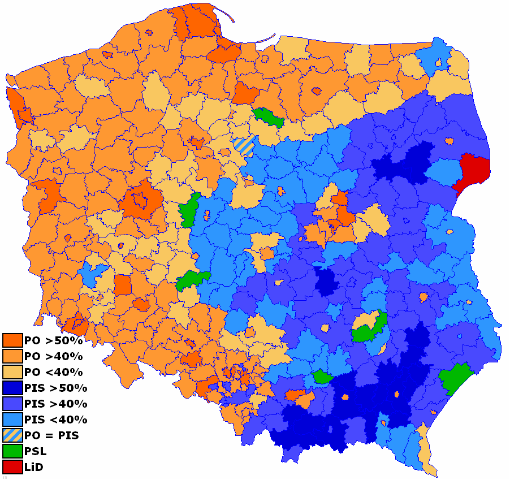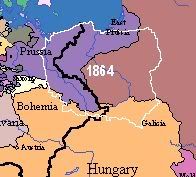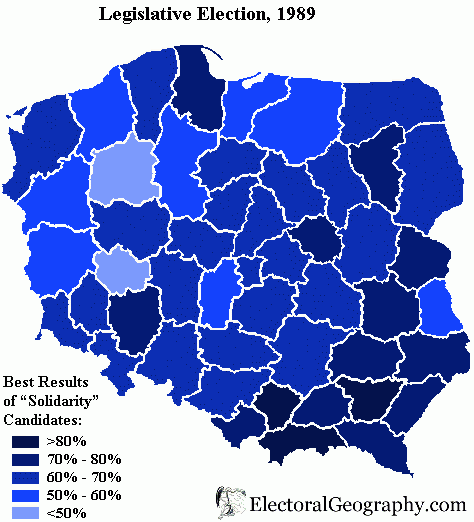By: Inoljt, http://mypolitikal.com/
The country Poland is comprised of two main political parties; the first is Prawo i Sprawiedliwosc (PiS) – “Law and Justice” in English. This party is a populist group which runs upon anti-corruption and anti-Communist credentials. The second party is the Platforma Obywatelska (PO) – in English the “Civic Platform” – a group espousing support for free market capitalism.
On October 2007, Poland held parliamentary elections between the two parties. Most of the Western media backed the Civic Platform (PO), disliking the unpredictability of the Kaczynski twins (leaders of Law and Justice). Here is a map of the results:
More below.
As it turns out, the Civic Platform (PO) won the election, taking 41.5% of the vote. Law and Justice polled 32.1%, with the rest of the vote going to third parties.
A clear regional split is apparent in these results. Poland’s southeast – with the exception of Warsaw – generally voted for Law and Justice (PiS). On the other hand, support for the Civic Platform (PO) took a sickle-like shape along Poland’s northern and western borders.
These patterns are not random. Take a look at pre-WWI Imperial Germany superimposed upon this map:
As the map above indicates, there is a powerful correlation between the borders of Imperial Germany and support for the free-market, pro-Western Civic Platform (PO) Party. In contrast, areas that voted strongest for Law and Justice (PiS) used to belong to the Austrian-Hungarian and Russian empires.
An exact map of Poland’s pre-WWI boundaries looks as so:
These voting patterns have very little to do with any actual German presence in pro-Civic Platform regions. Few Germans live in the regions that used to belong to Imperial Germany; after WWII the process of ethnic cleansing effectively expelled them all from modern-day Poland.
The reason, rather, involves economics. The German Empire was far more economically developed than the Russian and Austria-Hungarian empires. This legacy is still present today, as Poland’s 2007 parliamentary elections showed quite starkly.
An interesting instance of Poland’s “German” divide occurred during the 1989 parliamentary elections. One may recognize this date: it was the year that communism fell in Poland. In these elections the Polish communists actually competed directly with the anti-communist Solidarity movement.
Here are the results:
Solidarity, of course, won in a landslide victory – which is why communism fell in Poland. Yet even in these elections one can make out the regional, east-west divide in Poland. Surprisingly, the more “Western” and economically developed regions actually gave stronger support to the Communists.
All in all, Poland’s electoral divide provides a powerful example of how long-past history can influence even the most modern events. Whatever the political parties of Poland’s future, and whatever their political positions, one can be fairly sure that Polish elections will continue to replicate the boundaries of pre-WWI Germany for a long, long time.




The one on Ukraine and the Russian language was fascinating, too. Well done.
They also remind me that in cities that aren’t Los Angeles, ancient history goes beyond the 1950s.
I never realized that Poland had a geographic divide like this. Most of the Germans were expelled following the Second World War so maybe the Poles in those areas were more grateful to the Communists for that? Other than that, I have no explanation.
I follow Polish politics/current affairs in addition to US, German, and British, and I think you did an excellent job illustrating the geographic divide between the PiS and PO. I just on read on the Polskie Radio website yesterday that the PO is up big in two recent polls, 27 and 12 pts respectively, over the Pis. I expect that to narrow by the time election day rolls around, just as the polls narrowed substantially in the recent special election for President.
Polish Radio Link: http://www.thenews.pl/national…
I do want to point out a big exception to your analysis of the 1989 election, though: Solidarity originated in Gdansk, formerly known in German as Danzig, and romped in that district.
Hi – excellent work
I just want to point out two other factors that characterise the former German parts of Poland besides a more developed infrastructure etc.
Especially important is the farm structure. Poland is probably the country in Europe with the greatest proportion of the populantion still depending on farming. – in the east often on an almost subsistence level on very small farms of just a few acres. It was also the only of the former communist countries, that allowed the farmers to keep the private ownership of the land. Only very large estates were turned into state farms, most of these seized from the german nobility that dominated the essentially feudal rural Prussia. So in the west you had large state farms, operated by state workers, mixed with private farms, but even these were (and are) much larger than in the east, even if they are still small by international standards.
The other factor is that as the Germans were expelled after WWII, Poles from the part of the country seized by the Soviet Union (today in Russia) resettled the area. So much of the population originally has the same background as in the East – but in the West they have been uprooted from the small farmholdings and the villages, where their families had lived for centuries, and an much larger part of them have been paid workers, even in the countryside.
This amounts to a tradtional rural culture in the East, always poor but today really struggling to hang on in a modern economy. Even as many now have left agriculture this is the world a large part of the population grew up in and which is vanishing before their eyes. In the west you have the remains of a rural worker culture, originally held up by the communist economic structure, mixed with farmers on somewhat bigger farms doing a little better competing on market economy terms. With the whole structure of society rebuild from the ground after WWII it is also less deeply rooted in traditional lifestyle.
And as Inolijts map shows this makes an excellent base for a nationalist, catholic, conservative, change-resisting party in the east and a more western-looking, market-oriented, reformist and less socially conservative party in the west (and in the big cities).